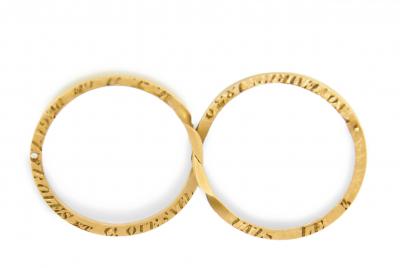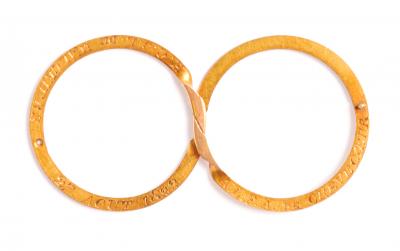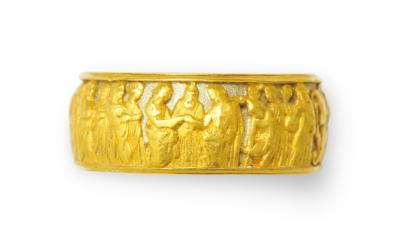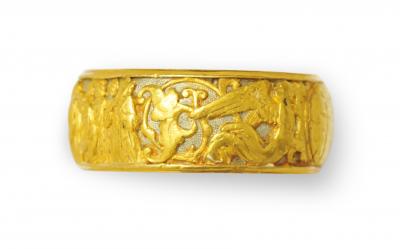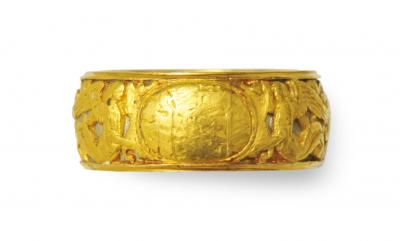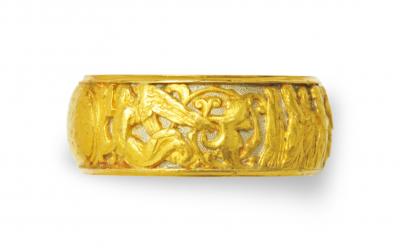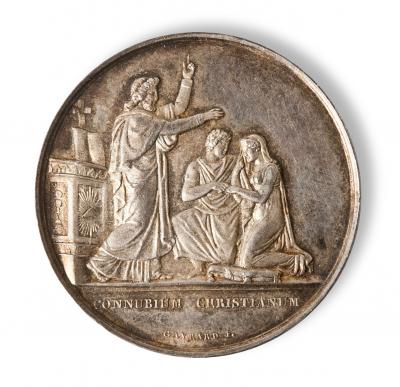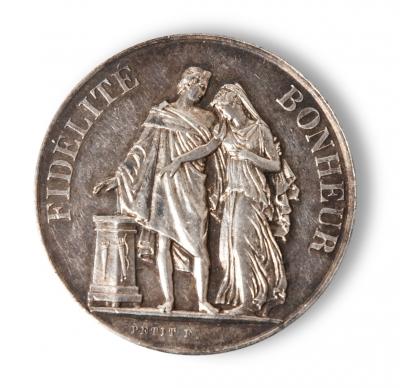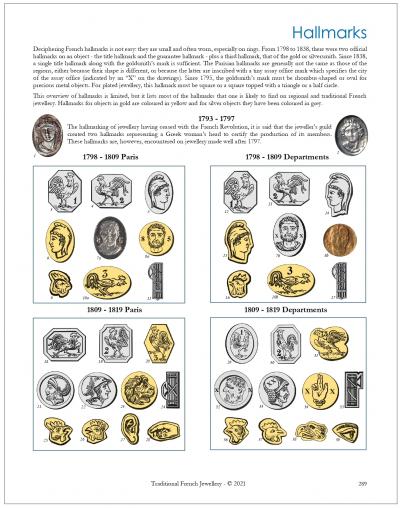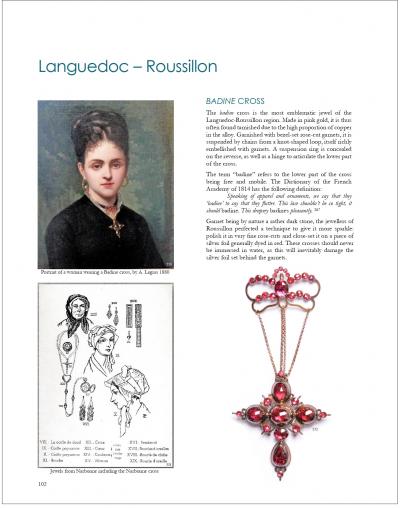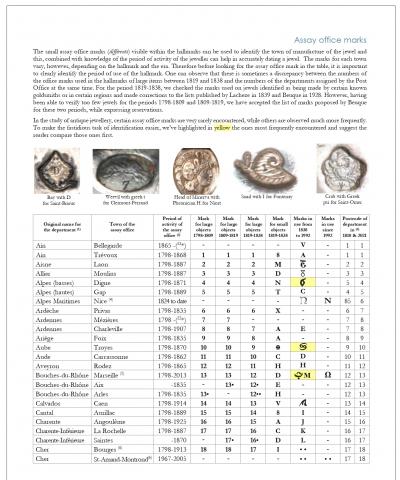Marriage

French traditional jewellery - marriage
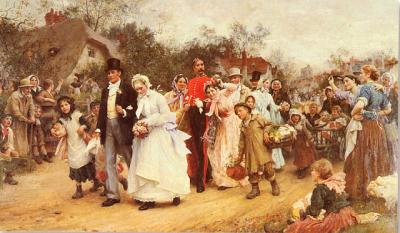
The village wedding by Samuel Luke Fildes
click on the photos to enlarge them in high resolution
The wedding ring
The wedding band, very important because it would be blessed by the priest and then exchanged during the ceremony, was traditionally in yellow or rose gold, and sometimes hollow or gold plated for modest budgets. The oldest ones, called "tors", were made of two gold wires twisted and then soldered together. Today, white gold and platinum are the most popular, and with the abrupt rise in the price of gold, multiplied by four in five years, we see a tendency towards inexpensive wedding bands in stainless steel, tungsten or titanium. Note that it is possible to purchase wedding bands specially made with a weak spot designed to break should the ring be caught in a machine. Very few are purchased, a pity as numerous fingers would be saved from amputation each year were their use to be generalised.
Gimmel rings, twinned wedding bands, were sometimes offered in the early nineteenth century. These gimmel rings are unique in that they open up into two distinct bands which nevertheless remain joined, and which symbolise the two souls joined together, separate and yet inseparable. The names of the couple as well as the date of the marriage were usually engraved on the inside. The workmanship of these rings is fantastic, they were entirely hand finished and the joint is almost invisible and only a knife-blade can tease them apart, a fingernail is too blunt. One also sees gimmel rings made of three distinct bands which slide apart so that the two clasped hands open to reveal a heart on the central band. The word gimmel is derived from the French jumelle, meaning twin. I think we can assume that the symbolism of the two souls united would have also applied to the tors rings, and that the gimmel rings were derived from the tors. Antique tors and gimmel rings are very rare today because they are fragile and it was difficult to repair them or change their size; the majority were certainly melted a long time ago.
|
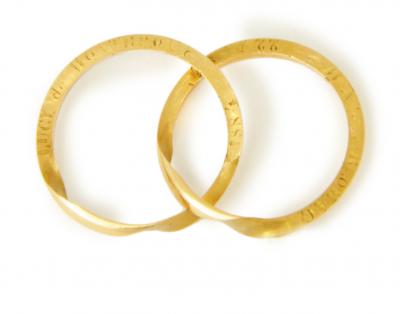
gimmel ring double
wedding band engraved 1884
|
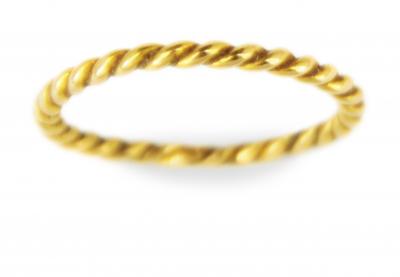
tors ring, gold
|

gent's wedding or signet ring
|

gimmel ring triple
wedding band shown open |
|
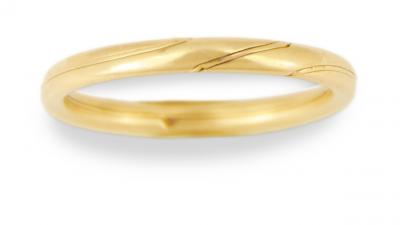
gimmel ring triple wedding band -
shown closed |
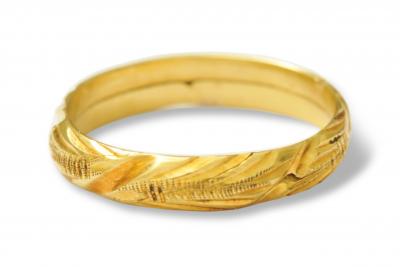
gimmel ring or twinned wedding band, shown closed
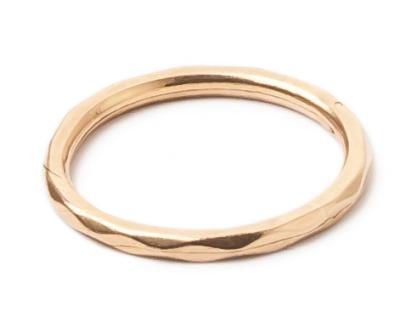
gimmel ring or twinned wedding band
shown closed |
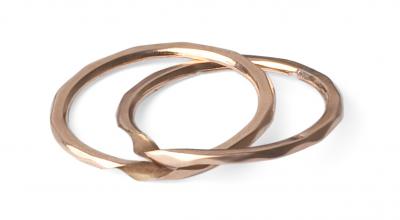
gimmel ring or twinned wedding band
shown open |
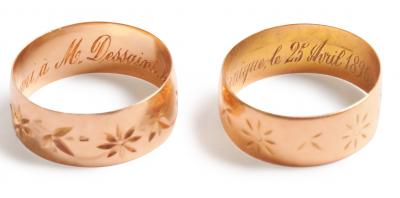
pair of rose gold wedding bands worn by a couple, chiselled gold, 1896
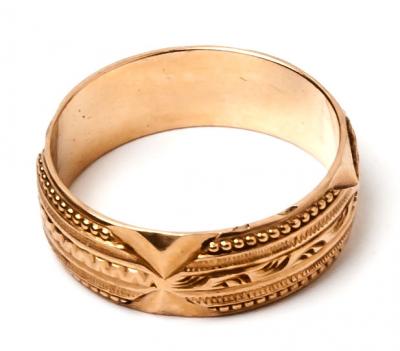
antique pink gold
wedding band |
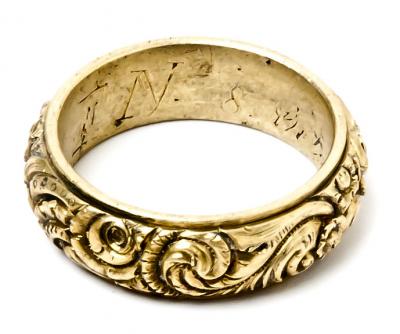
antique yellow gold
wedding band |
|

antique pink gold
wedding band |
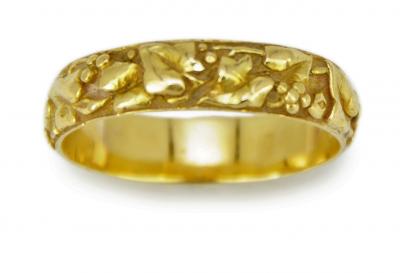
antique yellow gold
wedding band |
four views of a splendid wedding ring made for the marriage of Olivier de la Grange with Laetitia Boyer, the 12th of August 1846
The marriage treizain
|
Since at least the fourteenth century, and probably since the time of Clovis, the groom offered the bride during the ceremony a "treizain de mariage". It consisted of thirteen coins or tokens in gold or silver. The number thirteen represented Jesus and the twelve apostles, and the act of giving them symbolised a compensation to the bride for the goods or land brought by her to the union. The coins or tokens were generally presented in a special metal cylindrical box, a case or a purse, the latter being made of gold, silver, gold-plated silver or silk. Between one and three coins were kept by the priest, the others were destined to be guarded a lifetime but were almost always spent in one of the times of need that all couples go through. This is why complete treizains are extremely rare today. In the Treasure of Erfurt, in Germany, discovered in 1998, we can see an empty silver gilt treizain box dated to the first half of the 14th century. (1)
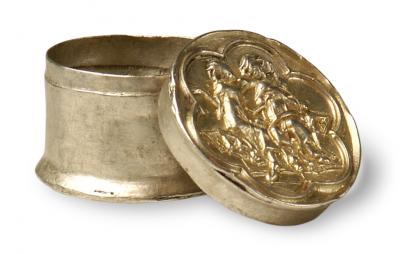 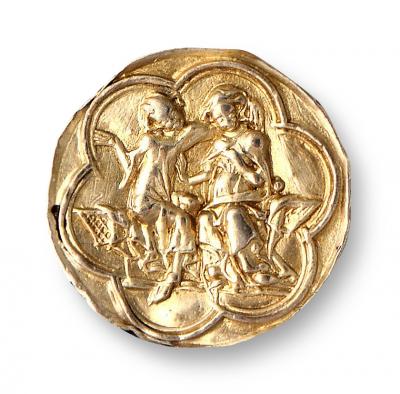
silver gilt treizain box found in the treasure of Erfurt, 14th century
The tokens found in sets of trezains are stamped with various texts: "pour épouser" - "pour espouser" - "denier tournois" - "denier de foy" - "de nous deux coeurs une seule foy" - "pour toujours unis" - "la foi nous unit". Silver coins, if offered, were frequently gold plated (by the mercury process) and sometimes engraved on one side with the initials or family crest of the couple. The oldest treizain tokens were often bracteates (from the latin bractea, a thin piece of metal), thin tokens with a design in relief on one side and incuse on the other. In some cases pairs of bracteates were soldered together to form a double-sided token, these are known as assembled bracteates. In the inventory of the collection of jewels of the countess de Sault performed in 1595 was noted "a red satin purse containing 13 Spanish pistolles and 13 small gold coins engraved with the arms of Créquy which were given to the countess for her two marriages" (2) (pistolles are small Spanish gold coins). The tradition of offering a treizain has ceased in France but continues today in Spain where small purses in velvet containing thirteen silver or silver plated tokens are still offered.
|
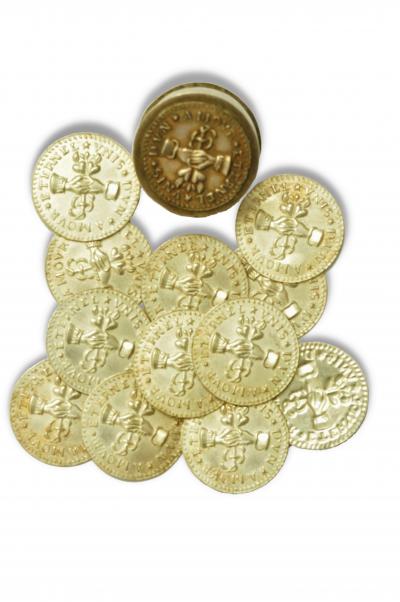
Marriage treizain complete with its silver
box and 12 bracteates, circa 1750-1800
Stamped "UNIS D'UN AMOUR ETERNEL"
still shiny after 200 years in an air-tight box!
|
 |
It's worth bearing in mind that until the French revolution in 1789, the monetary system was based on the Roman one : twelve deniers (denarius) equalled one sol (solidus) and twenty sols one pound (libra). There were thus 240 deniers or pennies in a pound, not very practical for calculating! (This system was replaced by the Germinal franc decimal system in 1803 by Napoleon and, incredibly, survived in England and its colonies with their pennies, shillings and pounds until the introduction of the decimal system in 1971 for England and a bit earlier in the other commonwealth countries.) A treizain thus represented one denier, the smallest coin, and a sol, the next largest. When Clovis sent his emissaries to ask for the hand of Clotilde, they brought with them a denier and a sol.
marriage treizain, one-sided bracteates, circa 1750-1800
the legend reads - LA FOY NOUS UNIS (faith unites us)
|
|
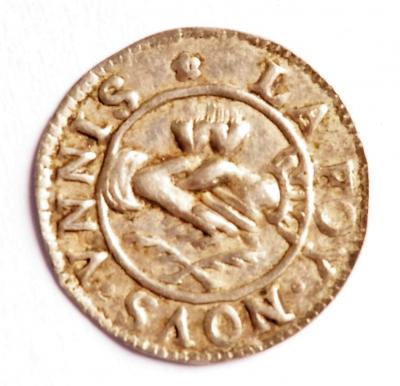
detail of silver marriage token,
assembled bractéate, circa 1750-1800
'LA FOY NOUS UNNIS' actual size = 10mm
|
|
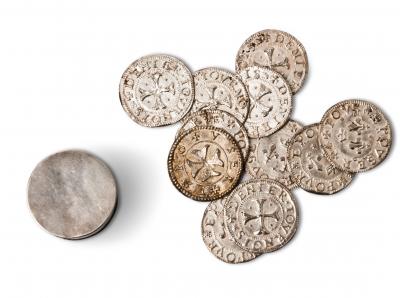
marriage treizain complete with its silver
box and 12 assembled bracteates, circa 1750-1800
Stamped "DENIER TOURNOIS * POVR ESPOUSER"
|
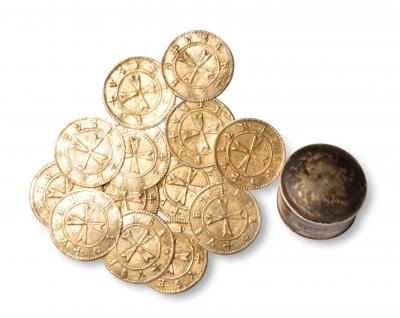
marriage treizain complete with its silver box and 13 gilt silver bracteates, circa 1750-1800
Stamped " ESPOVSER"

marriage treizain of 25 centimes coins from 1844 - gold-plated in their fitted case
click on the photos to enlarge them in high resolution
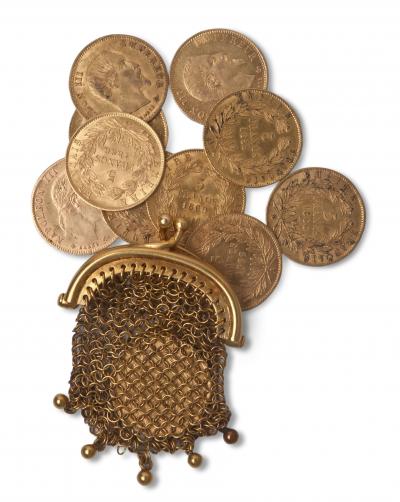
marriage treizain purse in
gold with 12 gold
5 francs coins |

marriage treizain purse in
gold with 12 gold
5 francs coins |
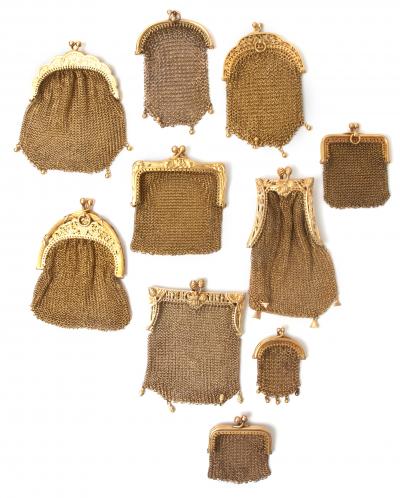
selection of gold purses,
period Napoléon III (25%)
|
|
|
|
|
|
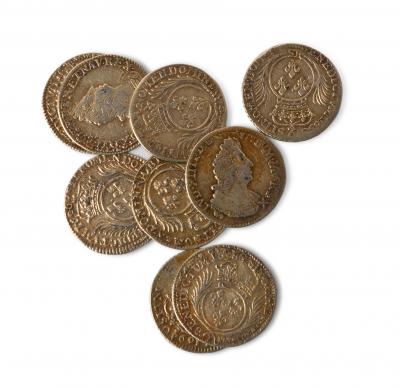
treizain (incomplete) made with gilded 1/12 écu silver coins, circa 1690
|
The marriage medal
|
The treizain was replaced towards the start of the nineteenth century by a marriage medal, generally of silver, sometimes of gold, the reverse or edge of which was generally engraved with the names of the couple and the date of the ceremony. The marriage medal was blessed along with the wedding bands during the ceremony by the priest.
Later, the marriage medal was sometimes mounted as a brooch or pendant and worn by the bride.
Today, in some towns, the mayor offers the couple a bronze marriage medal after the civil ceremony, (which by law has to precede the church ceremony).
wedding medal in gold
|
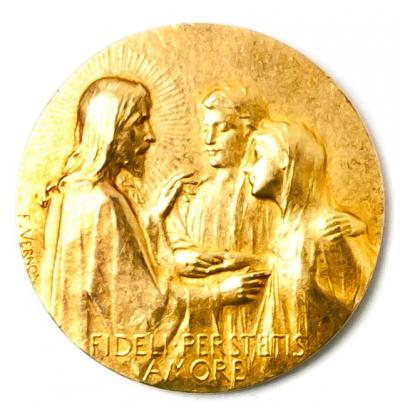
|
|

silver marriage medal
|
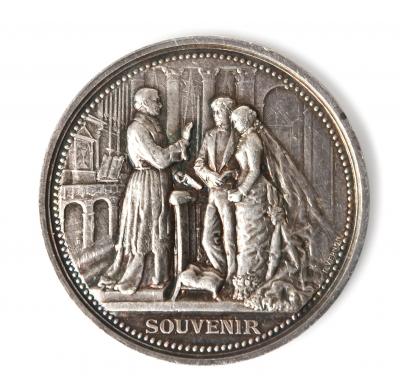
silver marriage medal
|
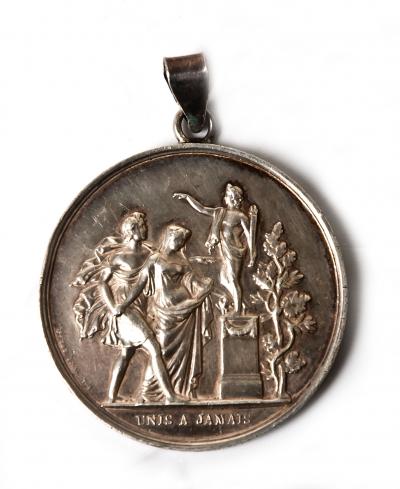
silver marriage medal |

very large gold wedding medal, 1876, obverse |

very large gold wedding medal, 1876, reverse
|
originally a presentation medal for the coronation of king Charles the tenth in 1825, this medal was engraved in 1876 to commemorate a marriage

engraved edge of wedding medal shown above, celebrating the marriage of
Eudoxe Regnouf de Vains and Isabelle Poujol d’Acqueville on the first of February 1876
|
|
|

silver marriage medal
|
|
|
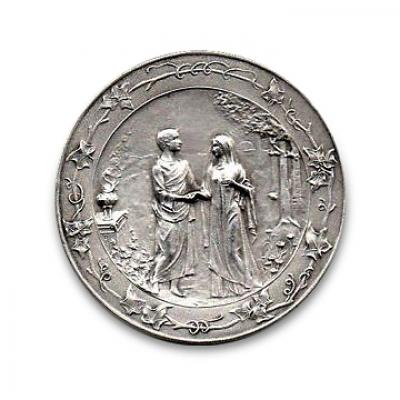
marriage medal in silver engraved
by Mattei, the border in ivy represents
eternal love : "I attach myself or I die" |
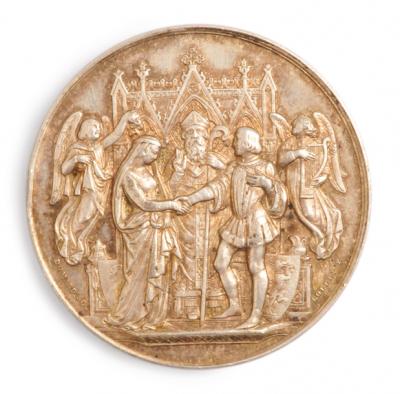
silver marriage medal
|

silver marriage medal |
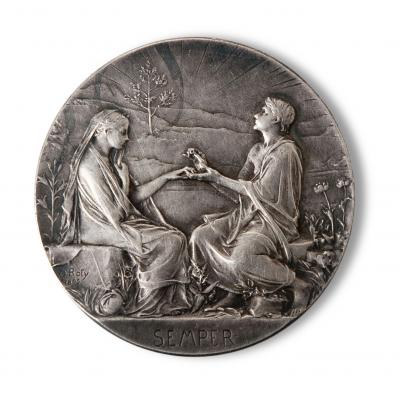
silver marriage medal
|

marriage medal in silver gilt
|
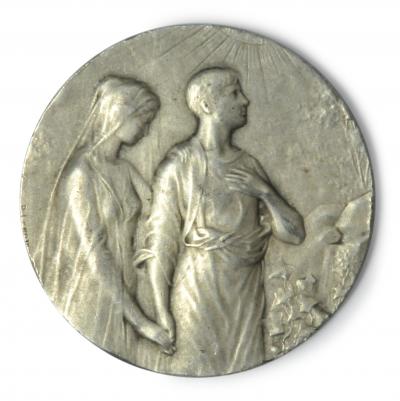
wedding medal in silver from 1914 - obverse |
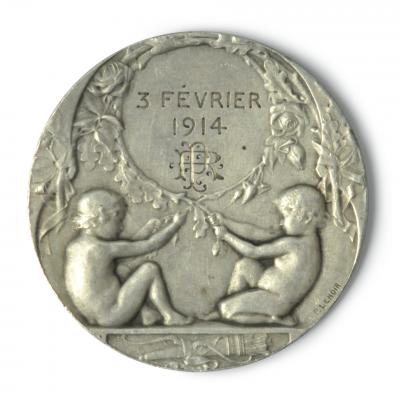
wedding medal in silver from 1914 - reverse |
|
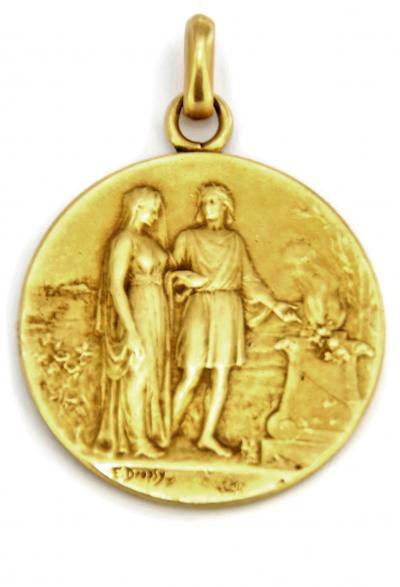
gold wedding medallion, 1912, obverse
|
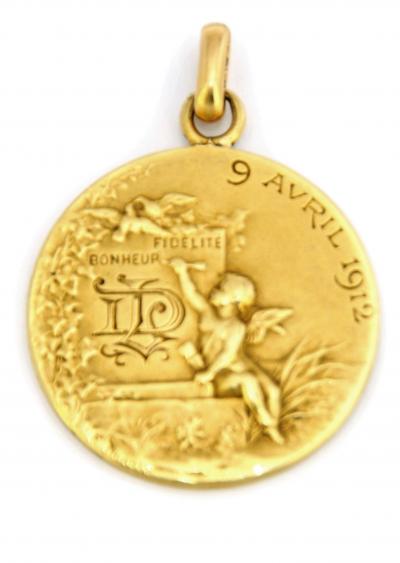
gold wedding medallion, 1912, reverse
|
200%
|

wedding medal in silver plated bronze offered
by the mayor and town councillors of Carcassonne
|

marriage medal in silver plated bronze offered
by the mayor and town councillors of Carcassonne |
|
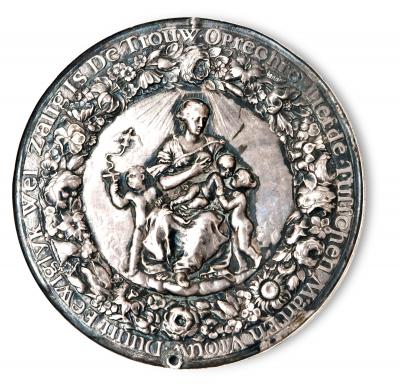
marriage medal in silver, by Pieter van Abeele, circa 1657,
made in Holland, collected in Béthune, northern France, obverse
"Oprechte Liefde Tusschen Man en Vrouw
Duurt Eewiglyk Wel Zalig is de Trouw"
"True love between man and woman lasts forever,
so blessed is the fidelity"
|

marriage medal in silver, by Pieter van Abeele, circa 1657,
made in Holland, collected in Béthune, northern France, reverse
"Het Huwelyck is Goddelyke van Aart
Wanneer men Tsaam Vyt Reine Liefde Paart"
"Marriage is a divine institution whenever people
come together with true love"
|
click on the photos to enlarge them in high resolution
The wedding cup or loving cup
In some regions of France, the parents of the couple would present them with a silver or engraved glass wedding cup, which was used to give the toasts. The cup was brought out regularly in order to toast births, baptisms, communions and made its last appearance filled with holy water at the foot of the coffin....... The shapes of the Burgundy and Brittany wedding cups are quite characteristic; in other regions, they often shaped like a tall silver champagne glass engraved with a garter motif or like a silver teacup with a saucer.
The silver or glass cup was presented to the bride, while the bridegroom would receive a flat 'tasse-à-vin' or tastevin. In the past when people went out to eat, they would need to bring their own cutlery and the flat shape of the tastevin enabled it to be easily carried in a man's pocket. Both cups were engraved with the initials of the owners to prevent problems when retrieving the cups. Of course, silver was reserved for the wealthier couples; most couples had to make do with pewter, earthenware or even wooden cups and beakers.
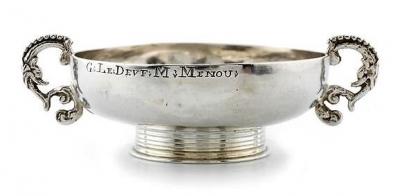
silver loving cup or wedding cup from Brittany circa 1716-1717
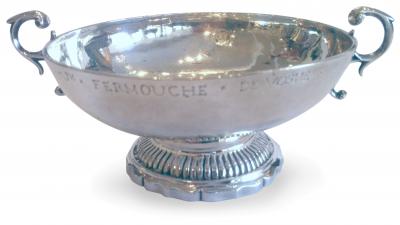
silver loving cup or wedding cup from Burgundy circa 1780 |
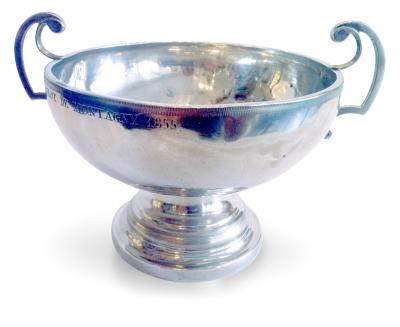
silver loving cup or wedding cup from Burgundy engraved 1855
|
50%

Silver tastevin
|

silver loving cup, not engraved with the initials of the couple.
note the garter motif around the cartouche. XIXth century
|
|
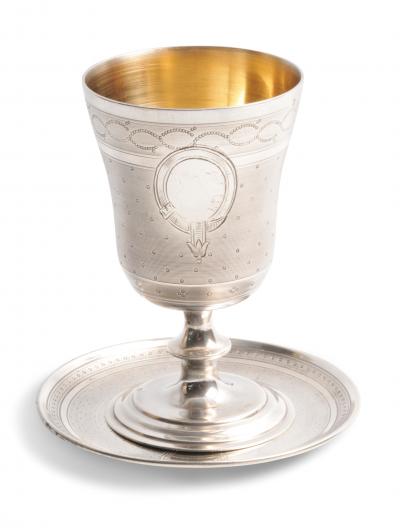
silver loving cup, the engraved initials of the couple have
been polished off.
note the garter motif around the cartouche. XIXth century
|
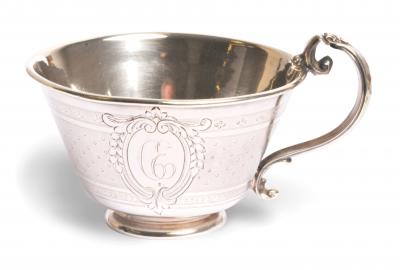
Silver marriage cup

Marriage in the Bresse region
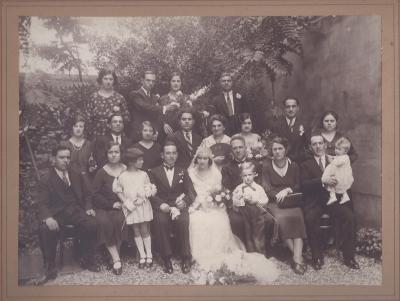
Marriage

Marriage - photographer Godart, Lille
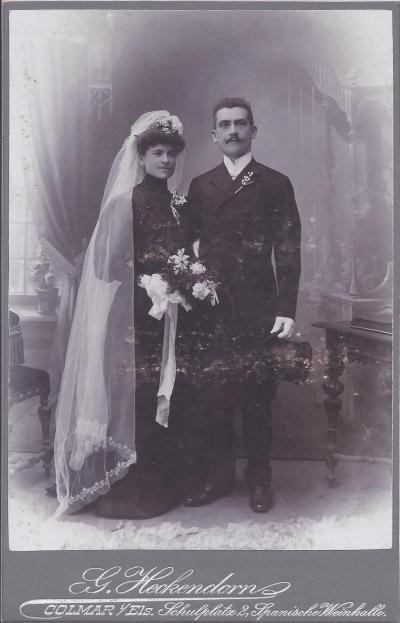
Marriage, photographer Henckendorn at Colmar
The silver cutlery service
A silver cutlery service was a very traditional gift often given to the couple, generally by the parents or by a wealthy relative. This silverware was brought out for fancy meals after having been polished to sparkle. Solid silver tended to be too expensive for most budgets and we notice that most silverware is in fact silver-plated, even though the recipients always believed it to be of solid silver.
A traditional service consisted of twelve spoons, twelve forks, twelve dessert spoons (also used as teaspoons) and a ladle. The knives were never offered with the service as the superstition claimed they would "cut" the friendship. Until around 1950 the knives, sold separately, had handles of ebony, horn, ivory or Celluloid and thus didn't match the rest of the service. Since then the knives have matching silver plated handles and are bought and offered with the rest of the service.

The wedding book by Arthur Blair Leighton
New book - Traditional French Jewellery
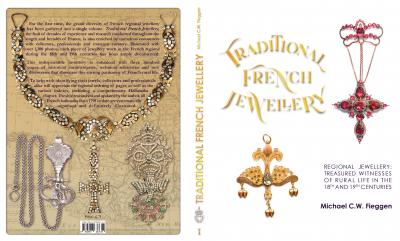
Book - Traditional French Jewellery - order here direct from the author
Dear collectors, auctioneers, dealers and jewellery lovers,
You have visited the site www.bijouxregionaux.com which since 2009 has listed all regional and traditional French jewellery, without advertising and without sales. By popular demand, this website is now finally available as a book, much more complete and with many new photos and texts that are not on the site. I traveled more than 4,500 km in 2020 to visit the various collectors and museums of France and to photograph, weigh, measure and examine their jewellery.
Large format of 23.5 x 30 cm, 304 pages, hardcover and fully illustrated with over 1300 jewels in color, this book is the first complete book on French regional jewellery and corrects the many errors and gaps observed in the other references and presents other regional jewels hitherto unknown to the public. You will find eight full pages on Breton pins and fibulae and many other jewels in museums and private collections that are not on this website. Over four months of research has gone into making the chapter on hallmarks the most reliable ever seen - clear illustrations of hallmarks have been made especially for this volume. And for the first time, collectors will have access to a complete list of all the assay office symbols, small signs withn the hallmarks that identify in which city the jewellery was hallmarked. The opening and closing dates since 1798 of the hallmark offices are also listed for the first time, allowing, with the office symbol, to better date your jewellery.
The print run of this book is very limited, which is why I recommend you order early. You will love this book I have had nothing but compliments and many clients have ordered more to offer as gifts.
To order, you can send a wire transfer or WISE transfer to Michael Fieggen - FR76 4061 8803 9700 0403 3233 171 – BIC – BOUSFRPPXXX - address Mike Fieggen, 280 rue Saint Honoré, Paris, 75001 France
Bank or wire transfer by www.wise.com in Sterling – Account holder - Michael Fieggen
IBAN - GB68TSBS30916200184462 BIC / SWIFT - TSBSGB2AXXX
Sterling cheques and PayPal welcome to address demosthenesparis@gmail.com.
Any questions ? Contact me at bijouregional@gmail.com or by telephone at + 33 1 4015 9000
One copy in French €75 Postage and packing €9 for France, €8 for Europe and overseas
Two or more copies in French €75 each Postage and packing €9 for the lot in France, overseas postage €8 each
One or more copies in English £75 sterling each Postage and packing £8 sterling each
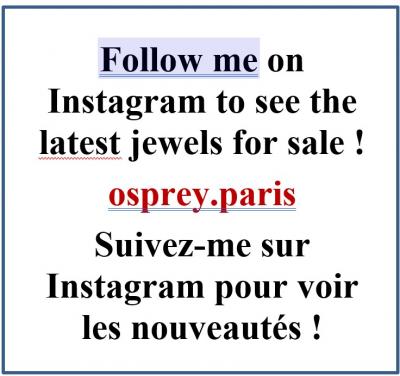
1 : CATOIRE, Christine., Treasures of the Black Death, The Wallace Collection, 2009
2 : LE BRETON, Gaston., Inventaire des bijoux et de l'orfèvrerie appartenant à Mme. la Comtesse de Sault, Imprimerie Nationale, 1882
Table of contents
weddding ring, engagement ring, diamond ring, bague de fiançailles, bague de foi, bague à la Duchess Anne, alliance en or, ivoire de Dieppe, argenterie, métal argenté, argent massif, ménagère en argent, manche à gigot, pelle à tarte, pince à sucre, louche, cuillère à ragout en argent XVIII, sucrier en argent, service de baptême en argent, théière en argent, rince doigts en argent, Christofle, Tiffany, Têtard Frères, Fabergé, Mappin and Webb, cafetière en argent, chocolatière en argent, plateau en argent, argenterie art déco, argenterie art nouveau, manches a côtelettes en argent, service à découper en argent, service à confits, cuillère à Absinthe, saupoudreuse en argent, passe thé en argent, verseuse en argent, casserole en argent, bijou régional, bijoux régionaux, bijoux et orfèvres en Haute-Normandie, bijoux des régions de Fran
French traditional jewellery - marriage











